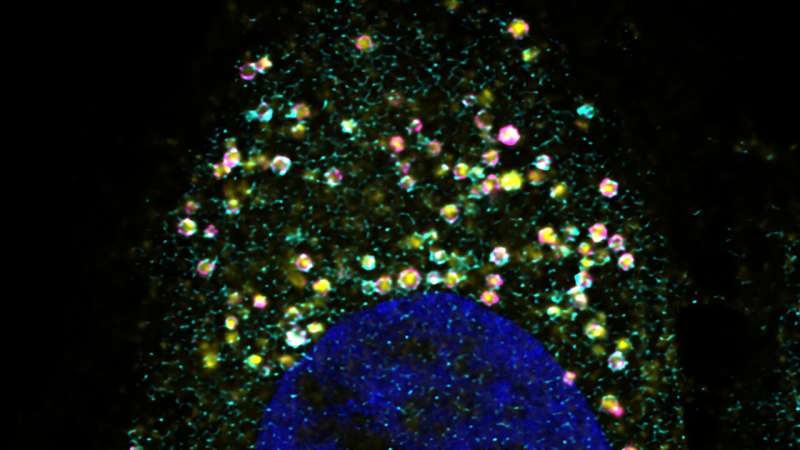Catabolic processes in cells: Controlling the danger within

Trillions of cells in our body work non-stop to keep us alive. This generates waste that is decomposed in specialized cellular organs. But what happens if the cellular trash cans don't work? Researchers assume that this is the cause of numerous diseases. Biologists at the University of Duisburg-Essen (UDE), together with a team from Munich, have now been able to show how cells protect themselves from their defective trash cans—because their contents are pretty serious.
Like organs in the human body, cells also have specialized structures inside them called organelles. These include the lysosomes, the cellular trash cans. They not only decompose the waste produced in the cell, they also break down invading pathogens such as bacteria. For this purpose, the small spheres are equipped with an acidic interior and an abundance of enzymes. They are surrounded by a membrane that traps the dangerous mixture inside.
If this membrane is damaged, the mixture spills into the cell itself and, in the worst case, leads to cell death. As a safety measure against the threat from within, cells have developed the following mechanism: they surround the perforated lysosome with another, intact membrane and transport it to another lysosome as if in a bag to be degraded.
In collaboration with a team from Ludwig-Maximilians-Universität Munich, the researchers of the group headed by UDE's Prof. Hemmo Meyer were able to show that this degradation process depends on various factors: The protein calponin 2 helps to form a new envelope around the damaged lysosome. Subsequently, it has to be removed quickly. Therefore, it is marked with the small molecule ubiquitin like a package with an address label. The p97 enzyme reads this label and then removes the calponin 2. If this process is impaired at any point, a damaged lysosome cannot be degraded and ultimately leads to the death of the cell.
A disrupted process could play a role in the development of various diseases such as tumors, inflammation, neurodegenerative disorders and cardiovascular diseases. "Our findings help to understand the processes involved in the development and progression of diseases," first author Dr. Bojana Kravic explains. "Effective therapeutic approaches can only be developed if we know these pathways."
The study is published in Molecular Cell.
More information: Bojana Kravić et al, Ubiquitin profiling of lysophagy identifies actin stabilizer CNN2 as a target of VCP/p97 and uncovers a link to HSPB1, Molecular Cell (2022). DOI: 10.1016/j.molcel.2022.06.012
Journal information: Molecular Cell
Provided by Universität Duisburg-Essen




















